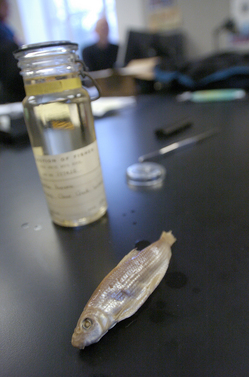University of Michigan regents finalize Museum of Zoology collections move
Millions of fish, reptile and amphibian specimens preserved in glass jars at the University of Michigan will be carefully boxed up and moved to a new home.
The move is one element of an $17.6 million plan to renovate a portion of the Alexander G. Ruthven Museums Building. Plans also include building a new storage facility within an existing campus building and moving most of the extensive Museum of Zoology wet collections from Ruthven to the new facility.

U-M plans to spend $17.6 million to build a new storage area for millions of specimens from the zoology department's "wet collection." A sucker fish that was collected from Kentucky in 1892 is preserved so well it looks like it was caught recently. The fish was close to extinction at the time it was collected and was CT scanned for further examination in 2008.
File photo
The renovations and move are necessary because the ethyl alcohol solution used to preserve many of the fish, birds, reptiles, amphibians and other animals in the wet collections is a fire hazard, officials said.
The U-M Board of Regents approved plans by architecture and design firm the SmithGroup of Detroit at its monthly meeting today, though the project got an initial go-ahead in December 2008.
"(Ruthven) was built a long time ago," said William Fink, director and curator of the Museum of Zoology, which houses collections used for teaching and research. "Over the years, the requirements for keeping these kinds of materials have changed."
Renovations and fire systems improvements of 6,800 square feet at Ruthven will allow a small portion of the collections to remain on-site for easy access for teaching and research. The rest will be moved to a 3600 Varsity Drive, where a 40,000-square-foot space within the existing building will be constructed under the plan.Â
The new space will have all the proper code attributes, such as a certain wall thickness and fire retardant systems, as well as a small lab area for visiting professors and students.
"There are 6 million specimens," Vice President for Finance Timothy Slottow said. "We're moving 90 percent to Varsity Drive. It's a much more efficient, safer and more functional space for these specimens."
Fink said the move is not unusual.
"It's a trend that's occurring over a lot of collections in the United States," Fink said. "They're moving these collections off the main campus sites to satellite areas where they can have more control over access, and so they can build a purposed building for these kinds of holdings that are up to date."
About the collections
The largest collections to be moved include fish, reptiles and amphibians, Fink said. Some, like the specimen that sits on a jar on his desk collected in 1890, are extinct.
Graduate students conduct primary research using the collections, and undergraduates learn from them in science courses.
"This is one of the few places in the country where undergraduate students can go into a classroom lab and see these animals really, and hold them in their hands, and touch them," Fink said. "At most places, you can't do that. They're stuck with pictures off the web, or video programs."
Current research with the wet collections includes a look at the impact on climate change on Michigan fish.
"We're examining what species are no longer being found in Michigan and what species are now being found, and which are moving up from the south," Fink said. "We are attempting to get funding to pursue that in a lot of more detail and more actively. We hope to go back and re-sample some of the sites from which we've got samples many years ago and see what's happened."
Fink is in charge of planning the move, down to the last detail, and has organized practice runs to estimate the time and resources that will be needed.
"It's an enormous job," he said of moving millions of specimens in glass jars to their new home. "It's mind boggling."
Other renovation projects approved Thursday include:
- A $6.4 million makeover for 61,000 square feet of Wolverine Tower. The renovation will relocate MHealthy to Wolverine Tower and create more shared space and shared staff opportunities for the various U-M units in the building.
- A $1.5 million chiller replacement in the Chemistry Building.
- A $2.2 million renovation of biology laboratories in the Edward Henry Kraus Building.
- A $3.8 million IT project to replace networking infrastructure and improve the campus wireless network.


Comments
Bill Nace
Fri, Jun 18, 2010 : 7:44 p.m.
Note that I only just found out about this post many months later; but to set the record straight, George Nace had nothing to do with the collection at the museum. He was a biologist, not a zoologist, and did not do that type of field work. He may have contributed some specimens, but he was more concerned with living frogs than pickled ones.
HBA
Sat, Nov 21, 2009 : 5:04 p.m.
It would be nice were the founder of the marvelous collection at the Zoology building were mentioned: the late professor George Nace. HA
A2K
Fri, Nov 20, 2009 : 8:55 a.m.
Very cool...I'd love to get in there and take some pictures of the collection *sigh*